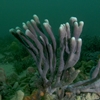General Description
A white, massive sponge species with irregular form. Size of about 20 cm.
Biology
The dense secondary fibre network that characterises these sponges leaves them compressible yet firm, a feature that renders them unsuitable for bathroom use.
Habitat
Reef and sandy areas, to depth of 5 m.
Sponge gardens
Reefs
Soft substrates
Distribution guide
Port Phillip in Victoria.
Species Group
Depth
Water Column
Max Size
20 cm
Diet
Plankton or particles
Commercial Species
No
Global Dispersal
Recorded in Australia
Species Code
sp. MoV 6715
Identify
Conservation Status
- DSE Advisory List : Not listed
- EPBC Act 1999 : Not listed
- IUCN Red List : Not listed




